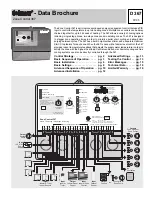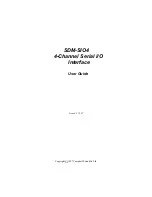
8
Sen — RTU 4 (8 and 10) terminals.
Common block for
RTU 1 and RTU 2
DIP switch set to Zone 1 Heating
• If the common block is used for a single One Stage heating zone, connect the RTU or Indoor Sensor to terminals
Com Sen
—
RTU 1 (5 and 6).
• If the common block is used for 2 One Stage heating zones, connect one RTU to the
Com Sen — RTU 1 (5 and 6) terminals
and connect the other RTU to the
Com Sen — RTU 2 (5 and 7) terminals.
DIP Switch set to Zone 1 Cooling
• If the 367 is used to enable a cooling system, then no RTU or Indoor Sensor is
connected to terminal
Com Sen — RTU 1 (5 and 6).
• If the 367 is used to control a cooling system the cooling RTU is connected to
terminals
Com Sen — RTU 1 (5 and 6).
• If a single stage heating zone is connected to output relay
2, connect the RTU or
Indoor Sensor to terminals
Com Sen — RTU 2 (5 and 7).
Two Stage RTU and Indoor Sensor Connections
It is best to start the Two Stage heating zones at output relays
1 and 2 and work towards
output relays
5 and 6.
Common Block for
RTU 1 and RTU 2
• If the common block is used for a Two Stage heating zone, connect the RTU or
Indoor Sensor to terminals
Com Sen — RTU 2 (5 and 7).
Common Block for
RTU 3 and RTU 4
• If the common block is used for a Two Stage heating zone, connect the RTU or
Indoor Sensor to terminals
Com Sen — RTU 4 (8 and 10).
Common Block for
RTU 5 and RTU 6
• If the common block is used for a Two Stage heating zone, connect the RTU or
Indoor Sensor to terminals
Com Sen — RTU 6 (11 and 13).
Output Connections
System Pump
Connect the live (L) side of the 120 V (ac) pump circuit through the
System Pmp —
System Pmp (1 and 2) terminals. The control closes a dry relay contact between these
terminals when operation of the system pump is required.
Zone Pumps and Valves
Note
Do not connect a zone pump and zone valve circuit to the same
Com terminal.
• If relay
5 is used, connect the zone pump or zone valve circuit to the Com 5-6 — 5
(25 and 26) terminals on the control.
• If relay
6 is used, connect the zone pump or zone valve circuit to the Com 5-6 — 6
(25 and 27) terminals on the control.
• If relay
3 is used, connect the zone pump or zone valve circuit to the Com 3-4 — 3
(22 and 23) terminals on the control.
• If relay
4 is used, connect the zone pump or zone valve circuit to the Com 3-4 — 4
(22 and 24) terminals on the control.
• If relay
1 is used for heating (DIP switch set to Zone 1 Heating), connect the zone
pump or zone valve to the
Com 1-2 — 1 (19 and 20) terminals on the control.
• If relay
2 is used, connect the zone pump or zone valve circuit to the Com 1-2 — 2
(19 and 21) terminals on the control.
Cooling System
If relay
1 is used for cooling (DIP switch set to Zone 1 cooling), connect the wires from
the cooling unit isolation relay to terminals
Com 1-2 —1 (19 and 20) on the control. The
367 closes a dry relay contact between these terminals when cooling is required.
STEP FIVE
TESTING THE WIRING
Each terminal block must be unplugged from its header on the control before power
is applied for testing. Pull straight down to unplug the terminal block.
The following tests are to be performed using standard testing practices and procedures
and should only be carried out by properly trained and experienced persons.
A good quality electrical test meter, capable of reading from at least 0 — 200 V (ac) and at
least 0 — 2,000,000 Ohms, is essential to properly test the wiring and sensors.
Com
Sen
UnO
Sw
5 6
RTU
1
12
RTU
6
11
13
Com
Sen
Com
Sen
14
16
Zo
In
15
17
Zo
Out
RTU
2
7
RTU
3
9
RTU
4
10
8
Com
Sen
Out
Sen
18
RTU
5
Com
Sen
UnO
Sw
5
6
RTU
1
12
RTU
6
11
13
Com
Sen
Com
Sen
14
16
Zo
In
15
17
Zo
Out
RTU
2
7
RTU
3
9
RTU
4
10
8
Com
Sen
Out
Sen
18
RTU
5
Com
Sen
UnO
Sw
5 6
RTU
1
12
RTU
6
11
13
Com
Sen
Com
Sen
14
16
Zo
In
15
17
Zo
Out
RTU
2
7
RTU
3
9
RTU
4
10
8
Com
Sen
Out
Sen
18
RTU
5
19 20 21
1
22
23
3
4
25
5
26
24
Com
5-6
27
Com
1-2
2
Com
3-4
6
19 20 21
1
22 23
3
4
25
5
26
24
Com
5-6
27
Com
1-2
2
Com
3-4
6
19 20 21
1
22 23
3
4
25
5
26
24
Com
5-6
27
Com
1-2
2
Com
3-4
6
19 20 21
1
22 23
3
4
25
5
26
24
Com
5-6
27
Com
1-2
2
Com
3-4
6
3
1 2
N
L
Pmp
4
Power
Pmp
System
12 13 14
16
15
17 18
Com
Sen
UnO
Sw
Out
Sen
RTU
5
RTU
6
Zo
Out
Zo
In
19 20
21
1
22 23
3
4
25
5
26
24
Com
5-6
27
Com
1-2
2
Com
3-4
6
19
20
21
1
22 23
3
4
25
5
26
24
Com
5-6
27
Com
1-2
2
Com
3-4
6
Com
Sen
UnO
Sw
5
6
RTU
1
12
RTU
6
11
13
Com
Sen
Com
Sen
14
16
Zo
In
15
17
Zo
Out
RTU
2
7
RTU
3
9
RTU
4
10
8
Com
Sen
Out
Sen
18
RTU
5
Com
Sen
UnO
Sw
5 6
RTU
1
12
RTU
6
11
13
Com
Sen
Com
Sen
14
16
Zo
In
15
17
Zo
Out
RTU
2
7
RTU
3
9
RTU
4
10
8
Com
Sen
Out
Sen
18
RTU
5


































